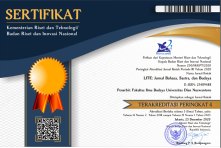ANALISIS DEIKSIKAL PRONOMINA DEMONSTRATIF KO-SO-A
Abstract
This research is aimed to find out and describe deictic analysis in ko-so-a demonstrative pronouns in Japanese. This research is a library study, in which the writer took reference and data from the internet, books, and dictionary. The source of the data was manga de manabu Nihongokaiwajutsu (Japanese comics), taken from 1 - 12 edition of Nihongo Jaanaru. The writer employed pragmatic approach under the framework proposed by Takahasi, et al (2000) and Teramura (1999). The data were collected by using inventory technique (note taking). The raw data were classified based on the theory of Takahashi, et al (2000), while the unit of analysis is every sentence containing ko-so-a demonstrative pronouns. The data were then analyzed cataphorically and anaphorically through the aforementioned framework. The result shows that the use of ko-so-a demonstrative pronouns are based on the physical location of referred thing or person, the contextual position of thing or person, and the shared knowledge toward referred thing or person. In addition, the writer also found empatitive deixis, i.e where the speaker’s emotion influences the use of ko-so-a pronouns. This, however, violates the theory of Takahashi, Teramura and Yuuji.
Keywords: anaphoric, cataphoric, deixis, demonstrative pronouns, ko-so-a
Full Text:
PDFDOI: https://doi.org/10.33633/lite.v7i1.1102
Article Metrics
Abstract view : 430 timesPDF - 1106 times
Refbacks
- There are currently no refbacks.
Copyright (c) 2011 Irma Winingsih
ISSN Online: 2548-9588
This work is licensed under a Creative Commons Attribution-ShareAlike 4.0 International License.
This journal is published by Universitas Dian Nuswantoro, Semarang, Indonesia.
Indexing & Archiving:
IN COLLABORATION WITH:
Indonesian Pragmatics Association
Konsorsium Program Studi Jepang Indonesia
Center for Foreign Language Training
Asosiasi Studi Pendidikan Bahasa Jepang Indonesia







































